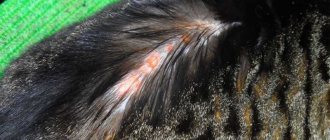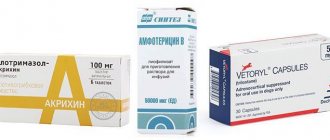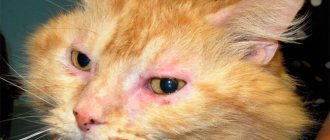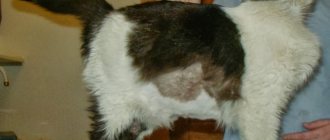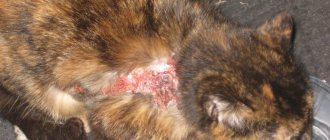Feline miliary dermatitis is a complex of diseases that manifests itself in cats through inflammation and rash with scabs around various areas of the cat's body, such as the neck, head, back and other places. If you notice that your cat has recently scratched and has several spots that look red, then they may be suffering from this disease. At HowMeow.com, we would like to give you a complete guide so that you can identify and treat this disease in your feline friend. Keep reading to know everything about miliary dermatitis in cats and what to do if this is your cat's problem.
The principle of dermatitis
Dermatitis occurs for various reasons:
- thermal reasons. This disease occurs when a cat's skin comes into contact with a hot object or liquid. Prolonged exposure to sun rays or low temperatures on areas of the body can also lead to thermal dermatitis;
- parasitic causes - bites of fleas, ticks, lice eaters. The saliva released when bitten by such an insect causes severe itching. In addition, these parasites constantly shed scales, hairs, and secrete waste products - all this causes a rash and skin irritation. This type of inflammation usually appears behind the ears and in the tail area;
Allergy to food in cats: how it manifests itself
If an animal is bitten by an ixodid tick, then swelling occurs at this site. A tick bite causes skin itching and inflammation. Then a bald spot and a rash forms. Subcutaneous parasites cause extensive rashes and blisters. If a cat's ears are affected, then dermatitis manifests itself in the form of redness and rash in the ears. Helminths provoke dermatitis by entering the animal’s body and multiplying in its intestines. They release toxic substances and waste products. In the presence of parasitic dermatitis, the cat literally tears its skin with its paws and teeth, trying to get rid of severe itching. By scratching wounds, an animal can introduce an infection there.
- irritants. Due to its increased sensitivity, a cat can react to contact with an external irritant. For example, domestic cats react to new shampoo, cleaning chemicals, and new items in the apartment. Dermatitis of the oral mucosa is possible after a pet comes into contact with poisonous house plants.
When the animal's immunity decreases, dermatitis occurs as a reaction to bacteria or fungus that could live on the cat's skin for a long time before. A favorable environment for fungal growth is warmth and humidity. Therefore, most often it occurs in the folds, in the armpits, on the chin, between the fingers, in the groin and tail.
Important! Flat-faced Persian cats are most susceptible to bacterial dermatitis. They usually develop fungus in the nose area.
Such dermatitis usually does not have an obvious form, sometimes becoming more pronounced, sometimes going into hibernation.
Miliary dermatitis: general concepts
A variety of dermatological diseases manifest as miliary dermatitis, formerly known as “miliary eczema.” The word “miliary” itself means “contamination, small seed, accumulation of seeds, grains,” that is, multiple roughness is felt under the fingers when palpating the skin. This term, in the end, perfectly describes the pathological condition of the skin in cats.
If you look closely, papules appear on healthy skin, covered with skin, scabs, dry and hard. This does not pose much inconvenience to the animal.
Miliary dermatitis is differentiated from:
- hypersensitivity to flea bites;
- reactions to food, medications;
- bacterial, yeast, viral and dermatophyte infections;
- pemphigus foliaceus;
- hypereosinophilic syndrome;
- urticaria pigmentosa, etc.
That is, if you notice skin roughness in a cat, you must contact a veterinary dermatologist at the RosVet VC. Despite the fact that in general miliary dermatitis is not considered a severe pathology, its cause must be identified and eliminated.
General symptoms
Skin diseases in cats: treatment of sores
With different causes, all dermatitis has similar symptoms:
- rash on the body;
- itching and scratching of affected areas;
- swelling;
- presence of lesions;
- blisters, blisters, ulcers;
- dry skin, appearance of cracks and scales;
- the appearance of weeping, damp wounds;
- hot skin in areas of inflammation;
- hair loss.
Flea dermatitis
Depending on the nature of the symptoms, dermatitis is distinguished:
- superficial – itching, redness and rash;
- purulent - the appearance of ulcers at the site of scratching and the addition of a secondary infection;
- wet - hair loss at the site of scratching.
Symptoms (with photos)
It is usually not difficult to identify the disease. In this case, the animal becomes covered with a small rash. It looks like red knots. Their structure is solid.
Other symptoms of the disease are as follows:
- Severe itching, this makes the cat want to scratch all the time. If you itch, the integrity of the skin will be compromised. This can cause viral and infectious diseases.
- The calm state of the animal is disturbed. The cat becomes restless, but the general condition is lethargic.
- In areas where the rash is localized, you can see a naked body.
- Usually the fur tends to fall out in clumps.
Types of disease
Allergies in cats: symptoms and treatment, medications
Dermatitis in cats is divided into two groups: simple - the occurrence of redness and itching upon contact with an external irritant; allergic - a reaction of the body, the response of the immune system to a foreign substance.
Wet dermatitis
Based on the origin of the disease, experts distinguish types of disease:
- bacterial – pathogens streptococci, staphylococci and other pathogenic bacteria;
- contact is the reaction of the skin to contact with external irritants;
- food – an allergic reaction of the body to food;
- parasitic – occurs when the body and organism of an animal are damaged by parasites;
- seborrhea – dermatitis of bacterial origin. It is expressed in keratinization of the skin and the formation of sebum. The first “bell” for the owner about the occurrence of a disease is the appearance of dandruff in the pet;
- Atopic dermatitis is an altered “incorrect” reaction of the immune system to food and other allergy triggers. This type of dermatitis is inherent in animals with a genetic predisposition to it, in cats, with sensitive skin and a tendency to inflammation and rashes;
- Pododermatitis in cats is an inflammation of the skin of the extremities, which results in dry pads, cracks and wounds. The paw begins to bother the animal;
- miliary - rashes of this type of dermatitis are small, similar to scattered millet grains;
- plasmacytic pododermatitis of cats - swelling and enlargement of the animal's paw pads as a result of infection in the plasma cells;
- allergic – the body’s reaction to medications, food additives, flowering plants, environmental degradation, household chemicals, etc.
This is a common cat disease. Miliary dermatitis is called eczema and even cat mangy. Veterinary dermatologists prefer to call this condition a special skin reaction. Indeed, these are symptoms of many diseases. Cat skin has a limited number of options for responding to different disease conditions. A small rash that feels like sandpaper and is accompanied by itching is not a disease, but a symptom of a disease. Miliary dermatitis is a scattering of small pimples, or nodules, on the skin, localized or covering the entire body. Typically, these pimples crust over and turn into scabs that can be easily felt through the cat's fur when you pet your cat. The term “miliary” means “millet-like” - the nodules feel like grains of millet to the touch.
Countless reasons
. Typically, this skin condition is a sign of hypersensitivity, an allergic reaction of the animal to a variety of things. Most often, this is a flea allergy, a respiratory allergy, or a food allergy. Hypersensitivity to skin parasites can cause the same symptoms.
Infectious diseases such as ringworm can also cause miliary dermatitis. Even bacteria, immune disorders, reactions to medications and digestive problems can manifest as crusts on the skin. One in six cases of miliary dermatitis is idiopathic, meaning that the cause cannot be determined. To cure this skin condition, you need to identify its cause and eliminate it.
Establishing diagnosis
. The location of the rash on the body can often provide an indication of its cause. If the rashes are on the head and neck, then most likely it is a food allergy. If the base of the Tail is affected, it is most often a reaction to fleas. If rashes occur throughout the body, doctors suspect respiratory allergies or atopy. Flea allergies and atopy are seasonal phenomena, while cats suffer from food allergies all year round.
Treatment of miliary dermatitis
begins with a series of tests aimed at identifying the cause of this condition. Fleas are probably the most common culprit. Since even one flea bite causes an allergic reaction, and cats themselves lick themselves zealously, it can be difficult to detect traces of fleas in a cat’s fur coat. You can suggest this way of checking for fleas: you scratch-scratch-scratch the cat's coat and put all the combed dirt on a wet white cloth. If it is flea dirt, then the black specks turn red.
Respiratory allergies are often caused by pollen, mold and indoor dust, and diagnosis requires intradermal testing. Suspected allergens are placed inside the skin (not under the skin) by scratching a shaved area of the cat's skin, which has previously been given a sedative. In the case of a positive reaction, the scratch swells and becomes redder after 5-15 minutes; in a negative reaction, there is no inflammation.
If miliary dermatitis is a food allergy, the rash will persist as long as the cat is exposed to that type of food. To diagnose a food allergy, a cat is put on a diet that includes ingredients it has never eaten before. If symptoms disappear, then some component of the old diet is to blame for the disease. These old components are added one by one to the new diet and monitored which one will cause an allergic reaction. This diagnostic feeding can last up to 12 weeks and should be done under medical supervision.
Almost every cat with miliary dermatitis has several different skin scrapings taken to determine whether there are skin parasites. Three species of Cheyletiella mites cause skin lesions, also called dandruff, because the white, moving parasites are often mistaken for skin flakes. These mites live in the horny substance (keratin) of the outer layer of skin. Cats become infected with them either through direct contact with infected cats, or through indirect contact with other parasites that carry this mite, such as fleas, lice and flies.
Otodectes cynotis
, commonly known as ear mites, can also cause miliary dermatitis on the head, neck, rump and paws. About three percent of cases of miliary dermatitis are due to this infection.
Demodicosis
, rarely found in cats, is known as glandular mite and is caused by the Demodex mite that lives in the hair follicle (hair follicle). It can also cause miliary dermatitis.
Cats suffering from head lice, that is, those infected with Felicola subrostratus, or chewing louse, may also show signs of miliary dermatitis.
Ringworm
in cats it can be caused by Mycrosporum gypseum, Trichophyton mentagrophytes or Microsporum canis, the latter being the causative agent of lichen in most cases. But any of the above parasites can cause signs of miliary dermatitis along with ringworm symptoms such as bald spots and redness of the skin. Therefore, when diagnosing stubborn miliary dermatitis, it is recommended to do a ringworm test. Pieces of skin and wool from the affected area are placed in a special nutrient medium that stimulates the growth of the culture of this fungus.
Treating itching is not treating the disease
. If you use standard allergy treatment, the symptoms of miliary dermatitis may be relieved, but they will return if this treatment is stopped. It is necessary to constantly monitor the presence of fleas in a cat if she is allergic to fleas. There are a huge number of products available on the market for the safe removal of fleas both from a cat and from its surrounding home environment.
The best therapy for respiratory allergies, according to experts, is frequent bathing of the cat: in this case, you wash off the allergen from its fur. A mild shampoo that does not dry out the skin or simply rinsing the cat with clean water is suitable for this. Some cats susceptible to atopy benefit from immunotherapy. Once the causative agent of the allergy is identified, the cat is given a series of injections of a drug based on this allergen in order to increase the resistance of the animal’s own immune system. Results appear slowly, and treatment usually lasts a year or more. Maintenance, preventive injections can be repeated periodically to make the cat feel more comfortable.
Miliary dermatitis caused by food allergies goes away as soon as you can find a suitable diet.
Except for the Demodex
, the skin parasites that cause miliary dermatitis are highly contagious, and if such an infection is detected, all animals in the household should be treated. Treatment consists of weekly treatment of animals with appropriate drugs for three to four weeks. After this first period of treatment, tests are done to check for parasites. If the test results are positive (that is, confirming the presence of the parasite), treatment continues with weekly screening tests until a negative result is obtained. After this, treatment continues for another week to consolidate the effect.
Many hidden causes of dermatitis can be treated well with cortisone. Steroids and antibiotics are prescribed to relieve severe itching or kill infection.
But the diagnosis of the root cause of dermatitis is very important; there is no point in treating itching by itself. The painful condition may worsen if ringworm is treated with cortisone. Modern treatment for ringworm may include the use of the new Microsporum canis vaccine in combination with hair clipping, medical baths, local application of ointments and environmental disinfection.
Diagnosis of the disease
A veterinarian should determine dermatitis in a cat, symptoms and treatment. Making a diagnosis of dermatitis does not cause difficulties for specialists. It seems more difficult to find the true reasons for its occurrence. During a conversation with the animal’s owner, the veterinarian collects anamnesis: living conditions, dynamics of the disease, the presence of chronic diseases and vaccinations. Then a visual inspection of the sick animal takes place.
Diagnostic algorithm:
- Inspection for fleas. However, a visual inspection does not exclude flea dermatitis, since these insects may not parasitize the animal, but only periodically bite it. The cat must be treated with flea control. If several individuals live in the room, then all domestic cats should be treated with flea control;
- The cat's feces, fur and skin scrapings are taken to exclude the presence of other parasites (lice, mites, helminths);
- Diagnosis of the presence of fungal or bacterial dermatosis in cats includes: taking a smear from the affected area of the skin, conducting a bacterial culture;
- The specialist also conducts skin allergy tests that can identify the body’s reactions to external irritants and determine allergic or atopic dermatitis in cats;
- Be sure to collect a general analysis of the animal’s blood and urine;
- If necessary, the veterinarian can prescribe a biochemical blood test, analysis of hormone levels and immunological tests;
- Also, at the discretion of the doctor, an ultrasound of the organs and a biopsy of areas of inflamed skin are performed.
Miliary dermatitis, its causes and symptoms in cats
Miliary dermatitis is not considered a full-fledged disease, but is interpreted by veterinarians as a specific reaction to a number of irritants. Initially, the pathology can be detected through palpation (palpation), it manifests itself in the form of uneven skin, “specks,” tubercles,” etc. In 99% of cases, miliary dermatitis in cats develops as a response to flea bites.
Miliary dermatitis: general concepts
A variety of dermatological diseases manifest as miliary dermatitis, formerly known as “miliary eczema.” The word “miliary” itself means “contamination, small seed, accumulation of seeds, grains,” that is, multiple roughness is felt under the fingers when palpating the skin. This term, in the end, perfectly describes the pathological condition of the skin in cats.
If you look closely, papules appear on healthy skin, covered with skin, scabs, dry and hard. This does not pose much inconvenience to the animal.
Miliary dermatitis is differentiated from:
- hypersensitivity to flea bites;
- reactions to food, medications;
- bacterial, yeast, viral and dermatophyte infections;
- pemphigus foliaceus;
- hypereosinophilic syndrome;
- urticaria pigmentosa, etc.
That is, if you notice skin roughness in a cat, you must contact a veterinary dermatologist at the RosVet VC. Despite the fact that in general miliary dermatitis is not considered a severe pathology, its cause must be identified and eliminated.
Symptoms of miliary dermatitis
Depending on the extent of the lesions, the pathology can be localized (in a small area of the body) or generalized (multiple). Sometimes there are no other lesions on the skin (wounds, scratches), but often the rash is accompanied by other primary or secondary symptoms.
Small, dry papules can be detected on:
- head;
- neck;
- lumbar region (sacrum);
- limbs.
If the pathological process is started, miliary dermatitis develops into a complicated, chronic form with symptoms of the EEG complex (feline eosinophilic granuloma):
- non-healing ulcers;
- eosinophilic plaques, granulomas.
Scratching, alopecia (bald spots), and erosions appear on the cat’s body. The itching is slight and, often, the owner does not notice that the pet is itching, since the latter skillfully hides it behind daily hygiene procedures.
Therefore, if a cat begins to pay too close attention to grooming, it is worth observing it or examining its skin. It is possible that the cause of intense cleanliness was miliary dermatitis.
Causes of pathological skin conditions
There are many etiological factors that can provoke skin rashes. It is customary to divide them into significant groups:
- hypersensitivity (reaction to flea bites, allergens in food, the environment, medications, etc.);
- ectoparasites (Trombiculae spp. (trombiculid mites), Cheyletiellaspp., Otodectes cynotis, Sarcoptes scabiei, Felicola subrostratus, Notoedres cati and Demodex spp.));
- infections (dermatophytosis, bacteria, FIV);
- other causes (pemphigus foliaceus, urticaria pigmentosa).
Diagnostics at the RosVet VC
It is impossible to make a diagnosis immediately just by looking at the cat; it will be necessary to conduct a series of clinical studies and exclude/confirm diseases that have similar signs, but have nothing to do with miliary dermatitis.
A veterinary dermatologist collects an anamnesis; it is important to know whether the cat is on a walk or not, whether there are other animals in the house, and what kind of skin condition they have. It is necessary to clarify how intensively the cat began to care for its fur, and whether there are any scraps of it on the furniture.
Diagnostic stages
Upon examination, papules are found under the fingertips with intense palpation. Collected and combed wool is inspected for flea excrement and live fleas, and Cheyletiella spp is sometimes found. or Felicola subrostratus.
A skin scraping is performed to identify/exclude the parasites Demodex spp., Notoedres cati, Sarcoptes scabiei.
Parasites are identified by examining feces using the flotation method, this is how Otodectes, Notoedres, Cheylitella, and Demodex gatoi mites are detected. The presence of Dipylidiumcaninum in feces increases the likelihood of flea infestation, since fleas are the intermediate hosts of these tapeworms.
Cytological examination of the skin is necessary to identify bacterial and yeast infections, diagnose pemphigus foliaceus and dermatophytosis. Wood's lamp examinations, dermatoscopy, PCR, and light microscopy are also performed.
Blood tests are prescribed to confirm/exclude systemic diseases (hyperthyroidism, retroviral infections), those in which there is a tendency for poor healing of wounds on the skin.
If food aversion is suspected, a specific diet is prescribed with the exclusion of suspicious foods from the cat’s diet. The study will last at least 6-12 weeks; one-time “samples” will not give results.
After I have established feline atopic syndrome and excluded all possible differential diagnoses, it is recommended to conduct intradermal tests and blood serum testing for allergens to select the correct treatment tactics.
Treatment of miliary dermatitis
The therapeutic actions of a veterinary dermatologist directly depend on the identified cause of the development of miliary dermatitis. For bacterial infections, systemic and antibacterial drugs are prescribed.
Chlorhexidine, silver sulfadiazine, and fusidic acid are effective as local treatments; the drugs are applied locally to the area of accumulation of papules.
For extensive lesions, it is necessary to apply the product to the cat’s entire body.
All medications are prescribed by the attending physician based on the identified cause of miliary dermatitis. Self-prescription is unacceptable, especially since it is not effective to act only on skin manifestations.
If you notice that your cat has begun to show excessive attention to the cleanliness of its fur, scratches itself, and when stroking small grains of dry papules under your fingers, don’t hesitate! Call the RosVet VC by phone, 24 hours a day. Make an appointment with a veterinary dermatologist; the clinic accepts animals 24 hours a day.
Source: https://Ros-Vet.ru/koshki/miliarnyj-dermatit-u-koshek/
Treatment methods
After diagnostic procedures, immediate comprehensive treatment of the animal follows. The domestic cat receives food recommended by a specialist and drug treatment. To rid an animal of fleas, special collars, sprays, shampoos, and drops are used.
Pododermatitis
The hair on the damaged areas is shaved off and ointment is applied to the areas of inflammation. To relieve itching and inflammation, zinc ointment, Lycaderm and synthymicin creams, and antihistamines are excellent. The doctor may prescribe an ointment that contains an antibiotic. If the disease is in an advanced state, it would be advisable to give injections to the cat to quickly heal the wounds.
Treatment of feline dermatitis using traditional medicine should only be approved by a specialist. To treat foci of inflammation, use a folk recipe for a solution prepared from tea tree oil, cedar, lavender and soapy water.
Important! If the doctor has diagnosed dermatosis in cats and the animal’s health is deteriorating, then it is advisable to leave it in the clinic under observation and to install IVs.
Equally important is nutritional control during treatment of dermatitis. If the allergic origin of the disease is established, then allergenic foods are excluded from the diet. Lack of proper treatment leads to partial or complete baldness of the animal.
Treatment of miliary dermatitis
The therapeutic actions of a veterinary dermatologist directly depend on the identified cause of the development of miliary dermatitis. For bacterial infections, systemic and antibacterial drugs are prescribed. Chlorhexidine, silver sulfadiazine, and fusidic acid are effective as local treatments; the drugs are applied locally to the area of accumulation of papules. For extensive lesions, it is necessary to apply the product to the cat’s entire body.
All medications are prescribed by the attending physician based on the identified cause of miliary dermatitis. Self-prescription is unacceptable, especially since it is not effective to act only on skin manifestations.
If you notice that your cat has begun to show excessive attention to the cleanliness of its fur, scratches itself, and when stroking small grains of dry papules under your fingers, don’t hesitate! Call the RosVet VC by phone, 24 hours a day. Make an appointment with a veterinary dermatologist; the clinic accepts animals 24 hours a day.
The danger of dermatitis in cats for humans
Dermatitis does not pose any danger to humans. It is not contagious in itself. Causes of its occurrence may cause concern. For example, if dermatitis is parasitic in nature, the pet owner has a chance of becoming infected. However, following the rules of hygiene and sanitary standards, such as thorough hand washing, using gloves when treating wounds, etc., will help to avoid this.
Atopic dermatitis
Dermatitis is quite treatable if the causes of its occurrence are correctly diagnosed. Here, as in getting rid of any disease, surgical intervention and a competent approach are needed. Independent selection of drugs for the treatment of dermatitis can lead to a deterioration in the animal’s well-being.
Scab in cats: description of the pathology
Scab or Favus is a fungal disease that affects the skin and coat. Reports that scab-causing fungi can attack internal organs are questionable. However, since Favus develops against the background of a weakened immune system, the development of septic processes under the influence of other microorganisms cannot be ruled out.
Infection occurs by contact or oral-fecal route. The reservoir of infection is rodents and stray cats. The incubation period depends on the condition of the pet at the time of infection. In weakened animals, pathological signs may appear after a few days, in stronger ones - after several months.
Effective medicines and preparations
Drug treatment for dermatitis is prescribed by a veterinarian depending on the type of disease being diagnosed in each specific case.
How to treat the disease depends on its forms and characteristics.
First of all, they get rid of the causes of the disease: remove fleas, ticks, lice eaters, change the diet, switching to hypoallergenic food, and replace the litter in the tray.
Antihistamines work well, as well as ointments that are used to lubricate the affected areas of the skin.
They are often of a hormonal nature, but there is no need to worry about this - such medications do an excellent job of their direct tasks, that is, they relieve itching, swelling, redness, accelerate skin regeneration processes and promote the healing of microcracks.
Remember! Injections of antihistamines can relieve symptoms and temporarily alleviate the animal’s condition, but they do not have a therapeutic effect.
Symptoms of the disease
Pathology manifests itself in the appearance of a red spot on the skin. At first it may be single, then multiple rashes appear, but this does not always happen. The cat constantly scratches the affected area, tries to lick it and bites. At the same time, the animal becomes restless and irritable, and sleeps poorly. As you scratch, the spots become crusty and may become weeping.
Dermatitis in a cat manifests itself at the initial stage as a red spot on the skin
Features of prevention for cats with allergies
First of all, healthy cat skin means following the rules of hygiene. Periodic washing and grooming will not only keep the outer coverings of the animal clean, but also promptly detect exoparasites that appear occasionally.
The owner of a pet must redouble his efforts to maintain cleanliness in the house: exoparasites and pathogenic microflora that can cause inflammation, as a rule, multiply in unsanitary conditions.
In addition, you need to pay attention to your pet’s contacts with other animals: limit contact with stray cats as much as possible, pay attention to possible symptoms in your pet’s pet “friends”.
In no case should we forget about periodic deworming - helminthic infestations significantly reduce the cat’s immunity, and therefore are an unfavorable factor in relation to dermatological diseases.
In addition, owners of cats with allergies must follow the correct diet for their pets and use medications with caution - food and medications can always cause an allergic reaction.
Treatment of the disease
Treatments for dermatitis in cats include corticosteroids, oral antibiotics, and medications to soothe itching and inflammation.
However, these medications may have side effects, so it is important not to self-medicate. In order to eliminate dermatitis in cats, treatment will be aimed primarily at killing fleas. The veterinarian may prescribe the use of medications that will help overcome the main symptoms. So, popular remedies for fleas:
- sprays (Bars, Celandine);
- shampoos (Lugovoi, Celandine);
- collars (Beafar, Leopard);
- drops (Hartz, Advantage).
Ointment for cats and the use of creams can be prescribed to eliminate the main symptoms (itching, dryness, dandruff). To cure the disease, you can use:
- salicylic-zinc ointment;
- Alusprey ointment;
- Stop itching;
- Solcoseryl;
- Lecaderm cream;
- Syntomycin cream.
The preparations have softening and disinfecting effects. Help eliminate itching, flaking and accelerate the regeneration of damaged tissue. Cats can lick the product, so after application you need to put a plastic collar on the animal's neck.
Treatment at home is more gentle and no less effective. Many home remedies can easily cope with the main symptoms and lead to recovery. Let's figure out how to treat dermatitis with folk remedies.
How to treat dermatitis:
- Mix 1 tbsp. nettle and thyme. Take a glass of boiling water and add 1 tsp. vegetable mixture. Cook for 2-3 minutes. Give 30 ml using a syringe without a needle 4 times a day.
- Mix alcohol, apple cider vinegar and honey in equal proportions. Let it brew for 1-2 hours. Apply to the affected part of the body in the form of compresses.
- Add 50 ml of turpentine to a bucket of warm water. Bathe the animal in the solution or dampen a cloth and thoroughly wet the affected area.
- Mix the following essential oils: lavender, cedarwood and tea tree with soapy water (5 drops of each oil per 1 liter of water). Treat the affected skin with the resulting solution.
Treatment at home also includes proper nutrition. You must monitor the quality of food, and if allergic dermatitis is detected, then you will need to find out what product the cat had such a reaction to.
Why is the word "military" used? Because the areas that were affected resemble millet grains (and this grain is called millet).
Miliary dermatitis in cats, in principle, is not a separate disease. A is a collection of symptoms. They can be caused by a large number of diseases, among them the following:
- allergies of various types, for example, food, atopy - its examples are allergies to flea bites, allergies to pollen;
- infections caused by bacteria;
- infections caused by fungi;
- so-called Yeast infections;
- damage by skin parasites of various kinds, for example, lice and ticks;
- if cats are very sensitive to parasites of the digestive system;
- immune diseases (autoimmune diseases);
- improper feeding (for example, the cat’s food is deficient in biotin and/or fatty acids);
- hormonal disorders;
- the reasons are unknown.
To make a diagnosis, the veterinarian will need information about the pedigree, content, health characteristics and lifestyle of the animal. The nature and quality of food is assessed, which is especially important for cats that eat ready-made food. Then the animal's blood, feces, urine, as well as hair and skin scrapings are taken for analysis.
It is extremely important to do allergy tests that will help identify a substance that is potentially dangerous to the animal and eliminate contact with it. This is an expensive procedure, and it cannot be performed in every clinic. However, without it, therapy may not give the desired effect. If allergy testing fails for some reason, searching for the allergen can take a long time. Identification of the provocateur is carried out using a trial method, when each food product is temporarily excluded from the diet and the animal’s reaction is assessed.
Treatments for dermatitis in cats include corticosteroids, oral antibiotics, and medications to soothe itching and inflammation. However, these medications may have side effects, so it is important not to self-medicate.
In order to eliminate dermatitis in cats, treatment will be aimed primarily at killing fleas. The veterinarian may prescribe the use of medications that will help overcome the main symptoms.
Ointment for cats and the use of creams can be prescribed to eliminate the main symptoms (itching, dryness, dandruff).
Cat dermatitis is a disease that manifests itself as a common allergic reaction. The animal becomes a target for the insect in two ways:
- Contact with any street animal, dirty shoes, outerwear.
- Weakening of the immune system and contact with a carrier.
Most often, infection occurs in summer or early autumn.
By piercing the upper layer of the dermis, the flea secretes saliva, which gets inside. Scientists claim that such saliva contains about 15 types of irritants. The substances in its composition contribute to the development of an allergic reaction. Most often, animals with weak immune systems are susceptible to it. Kittens under the age of 1 year also become targets of the disease.
Dermatitis in a cat is a disease that manifests itself as a common allergic reaction.
Dermatitis becomes fertile ground for the development of allergens contained in insect saliva. The disease also has consequences. The most common of them are:
- Atopic dermatitis. Characterized by redness, inflammation, and ulceration.
- Bacterial infections. Vomiting, diarrhea, fever.
To avoid death, it is necessary to conduct tests for diseases. If your cat's condition does not improve after starting treatment, you should contact your veterinarian again. He may change your treatment regimen or test for complications or underlying conditions. The owner of the animal can notice a positive trend by behavior.
How does the disease manifest in cats?
Symptoms of the disease are not always noticeable, so the owner should pay attention to the slightest changes in the behavior and well-being of the animal. Atopic dermatitis in cats manifests itself as follows:
- the appearance of skin itching, which provokes the animal to lick problem areas;
- When a cat sheds, it loses more hair than usual.
Atopic dermatitis may affect an animal at certain times of the year or may not depend on the season. During periods of exacerbation, cats experience itching in different parts of the body. The first manifestations of pathology can be noticed at the age of 8–9 months or a little later, during puberty. Its main symptoms:
- The appearance of bald patches on the animal’s body in areas affected by dermatitis. Often seen on the abdomen, eyes, ears and armpits. In appearance, it may resemble lichen, but unlike it, the hair along the edges of the affected areas does not fall off.
- Gradually, problem areas become covered with ulcers. Pathogenic microorganisms easily penetrate the skin through them, and they begin to rot.
- If the disease affects the limbs, the animal experiences excruciating itching and literally begins to eat them away. First, the cat licks and impatiently bites the skin, then gnaws it until it bleeds. Open wounds quickly become infected. If this happens again in the spring and summer, it can be assumed that the cause is pollen or dust from the street.
We are all used to the fact that people suffer from dermatitis. However, cats can also be susceptible to skin reactions that are not even a separate disease in themselves, but would be more correctly categorized as symptoms of other diseases.
Therefore, if you suspect that your pet has dermatitis - there must be such good reasons for this, which we will talk about below, you should definitely seek advice from a veterinary clinic, since only a veterinarian will be able to determine the type of dermatitis, clarify its cause and prescribe an adequate course of treatment for your pet.
More specifically, the term dermatitis combines many diseases of different etiologies. True, what they all have in common is that the disease manifests itself as skin irritations.
Feline atopic dermatitis
Text of the article and photos 1-14 from the book SMALL ANIMAL DERMATOLOGY A COLOR ATLAS AND THERAPEUTIC GUIDE KEITH A. HNILICA 2020
Translation from English: veterinarian Vasiliev AV
Clinical manifestations
Differential diagnoses
Diagnosis
Treatment and prognosis
- Prednisolone 2 mg/kg orally every 24 hours until itching and skin lesions resolve (approximately 2 to 8 weeks), then 2 mg/kg orally every 48 hours for 2 to 4 weeks, tapering to the lowest possible dose when dosing every other day if long-term maintenance therapy is required.
- Dexamethasone 2 mg orally 1 time every 1-3 days until itching subsides, then reduce to the least possible frequency of use.
- a Owners can reduce exposure to allergens that cause itching by removing them from the environment when possible. HEPA filters, air purifiers, and carbon filters can be used to reduce pollen, mold, and dust in the home. For cats sensitive to house dust mites, treating carpets, mattresses, and upholstery with benzyl benzoate acaricide once a month for about 3 months, and then every 3 months thereafter, can effectively eliminate house dust mites from the environment. Old cat litter should be discarded as it can accumulate house dust mite antigens. Reducing the humidity in the home below 40% relative humidity reduces house dust mite, mold and flea antigen load. To achieve this, highly efficient dehumidifiers are required that are capable of removing several liters of water from the air throughout the day.
- a Cyclosporine (Atopica) 7.5 mg/kg PO may be given every 24 hours until beneficial effects occur (approximately 4–6 weeks). You should then try to reduce the dosing frequency to 48-72 hours. Many cats can be maintained with once every 72 hours application. Cats must be free of feline leukemia virus (FeLV) and feline immunodeficiency virus (FIV). The risk of toxoplasmosis is a matter of debate; however, this risk appears to be very low at present.
- c Immunotherapy (allergy vaccine) is indicated if drug therapy is ineffective or unacceptable by owners, or if it causes unwanted side effects. Approximately 50-70% of cats with atopic dermatitis show a positive response to immunotherapy. Clinical improvement is usually observed within 3-8 months, but may take up to 1 year in some cats.
We recommend reading: Why the Bengal Cat Yells
Author's note
Photo 1 Atopic dermatitis of cats . Allergic alopecia in a cat. Similar alopecia lesions with excessive grooming can be caused by allergies to flea saliva, food allergies, and mite infestations.
Photo 2 Atopic dermatitis of cats. Multifocal alopecia of the trunk and lumbar region in a cat with atopy.
Photo 3 Atopic dermatitis of cats . Focal erythema with mild alopecia on the trunk of an atopic cat. This lesion was a mild eosinophilic plaque.
Photo 4 Atopic dermatitis of cats . Allergic alopecia, affecting almost entirely the front legs of an atopic cat. Note the complete absence of dermatitis (obvious inflammation), which often leads to the misdiagnosis of psychogenic alopecia.
Photo 5. Atopic dermatitis of cats . Fine focal crusts typical of miliary dermatitis in an atopic cat
Photo 6. Atopic dermatitis of cats . Alopecia and eosinophilic plaques on the abdomen of an allergic cat.
Photo 7 Atopic dermatitis of cats. This intradermal allergy test shows several positive reactions. Note the mild skin reactions that are typical for allergy tests in cats.
Photo 8 Atopic dermatitis of cats . Close-up view of the intradermal allergy test in Figure 7. Positive reactions appear as erythematous macules.
Photo 9 Atopic dermatitis of cats . Generalized “moth-eaten” truncal alopecia in an atopic cat.
Photo 10 Atopic dermatitis of cats . Allergic abdominal alopecia in an atopic cat. Skin inflammation may be mild and easily undetected.
Photo 11. Atopic dermatitis of cats . Allergic periocular dermatitis in a cat.
Photo 12. Atopic dermatitis of cats . A positive intradermal skin test for allergies in a cat. Note the extremely weak positive reactions compared to similar ones
tests in dogs.
Photo 13. Atopic dermatitis of cats . Alopecia on the lumbar region of a cat. Note that dermatitis in the lumbar region is not pathognomonic of flea allergy dermatitis in cats.
Photo 14. Atopic dermatitis of cats . Normal skin in the mammary gland area of a cat with atopy. Note that cats with autoimmune skin disease often have severe dermatitis around the periphery of the mammary glands.
Photo 15. Atopic dermatitis of cats . Severe erythema, alopecia and excoriation associated with hypersensitivity to environmental allergens.
Photo 16. Atopic dermatitis of cats . Hypersensitivity with subsequent self-induced alopecia. Note the lack of excoriation in this patient.
Photo 17 Atopic dermatitis of cats . Symmetrical alopecia in a cat. Note the well-demarcated areas of alopecia with no associated inflammation.
Photo 14. Atopic dermatitis of cats . This cat was licking her underbelly excessively, which caused complete alopecia of her underbelly.
Photo 18. Atopic dermatitis of cats . Eosinophilic blotches in an adult cat.
Photo 19. Atopic dermatitis of cats . Eosinophilic plaques, which are raised erythematous plaques on the trunk with areas of secondary excoriation due to intense itching.
Photo 13. Atopic dermatitis of cats . Alopecia on the lumbar region of a cat. Note that dermatitis in the lumbar region is not pathognomonic of flea allergy dermatitis in cats.
Reasons for development
Dermatitis is a special reaction of the skin to the presence of irritants, expressed by a rash and redness of the skin.
Considered a form of allergy. Veterinary specialists have not come to a clear conclusion as to what the root cause is.
Miliary dermatitis in cats can be caused by a variety of factors. They can be divided into two large groups: allergic and non-allergic in nature:
- Most often, this skin reaction is caused by an allergy - to ectoparasites (fleas), medications, the environment (dust mites, pollen). The disease is classified as one of the manifestations of eosinophilic allergic syndrome.
- Non-allergic miliary dermatitis can be caused by a fungal or bacterial infection (dermatophytosis, staphylococcus), or an autoimmune disease (pemphigus foliaceus).
Animals of any age and gender are affected; no breed predisposition could be identified.
- Allergies to food, pollen, flea bites.
- Infections of a bacterial, fungal nature.
- Presence of skin parasites.
- Increased sensitivity to parasites of the digestive system.
- Autoimmune diseases.
- Nutritional imbalance.
- Hormonal disorders.
- Diseases of unknown etiology.
- Violation of the animal's hormonal levels. This happens due to age-related changes during pregnancy. Improper, unbalanced nutrition will negatively affect the cat’s health;
- Bacterial, yeast and fungal infections;
- Allergic reaction to flea bites, ticks, plant pollen;
- The body of a domestic cat can react if it is infected with worms;
- Autoimmune disease.
A skin reaction for cats is a rare thing, this is due to the presence of an antibacterial agent in the saliva and on the outer integument of the animal. Minor infections and microtraumas often go unnoticed: the cat simply licks them, independently preventing further development of inflammation.
However, weak immunity, generalized skin lesions, extensive injuries of various etiologies can provoke a pronounced reaction.
Eczema is not always localized to one area of the skin. It happens that it spreads in small particles throughout the body. And by the time it is detected, the disease has already progressed.
Most often, the disease first affects the animal's tail and head. The disease causes severe itching. During attacks, the animal is capable of scratching terrible, bloody wounds on itself.
Treatment of skin disease
After making a diagnosis, the doctor selects a treatment regimen taking into account the stage of the disease. Initially, the pet is rid of helminths and ectoparasites using special medications, which will eliminate a skin reaction to this type of irritant. If the cat’s wounds become infected, antifungal agents and antibiotics are selected for the cat. With them, it is possible to suppress the activity of microorganisms and prevent a decrease in the pet’s immunity.
Another important point is to eliminate the allergen that triggered the atopy. If food is the culprit, a gentle diet or hypoallergenic food is selected. High-quality holistic products are not cheap, but they are made in compliance with the standards and recommendations of veterinarians and include a balanced complex of minerals, vitamins, and nutrients. Feed consumption is economical: a small portion is enough to satisfy the animal.
The diagnosis of “atopic dermatitis” is made to a cat only if it is confirmed that there is no reaction to the saliva of fleas, endoparasites and food. Clemastil, Suprastin, Chlorpheniramine and other popular antihistamines will help relieve external manifestations of cat allergies. When treating atopic dermatitis in cats, their effectiveness reaches 80%, which is much higher than in dogs (only 30%).
Hormonal drugs (Prednisolone and its analogues) have a noticeable effect. However, their use is fraught with serious complications: decreased immune defense, stomach problems, which is why hormones are prescribed in severe cases. If the animal’s condition is of concern, immunosuppressants are prescribed, the action of which suppresses the activity of the immune system. Taking Cyclosoporin gives good results. However, the drug has serious side effects (vomiting, hypertrichosis, gum dysplasia).
With the consent of the doctor, treatment with folk remedies is added to drug therapy. Treatment of problem areas on the animal’s body with aromatic foam based on essential oils brings benefits. To prepare it, you should prepare soft soap, cedar oil, rosemary and lavender. You need to mix whipped soap foam with oils in equal proportions, carefully apply to the cat’s body before or after bathing and rinse with water.
In the absence of infected scratches, the affected areas of the skin are treated with hydrocortisone or corticosteroid ointment (for example, Geoxyzone). Preparations with chloramphenicol and metronidazole help eliminate itching. Fish oil works similarly when used to lubricate problem areas of the skin. Sprays “Second Skin” and “Alusprey” have antiseptic properties. To prevent the animal from licking and injuring the wounds, a special cone or collar is put on it until the skin heals.
